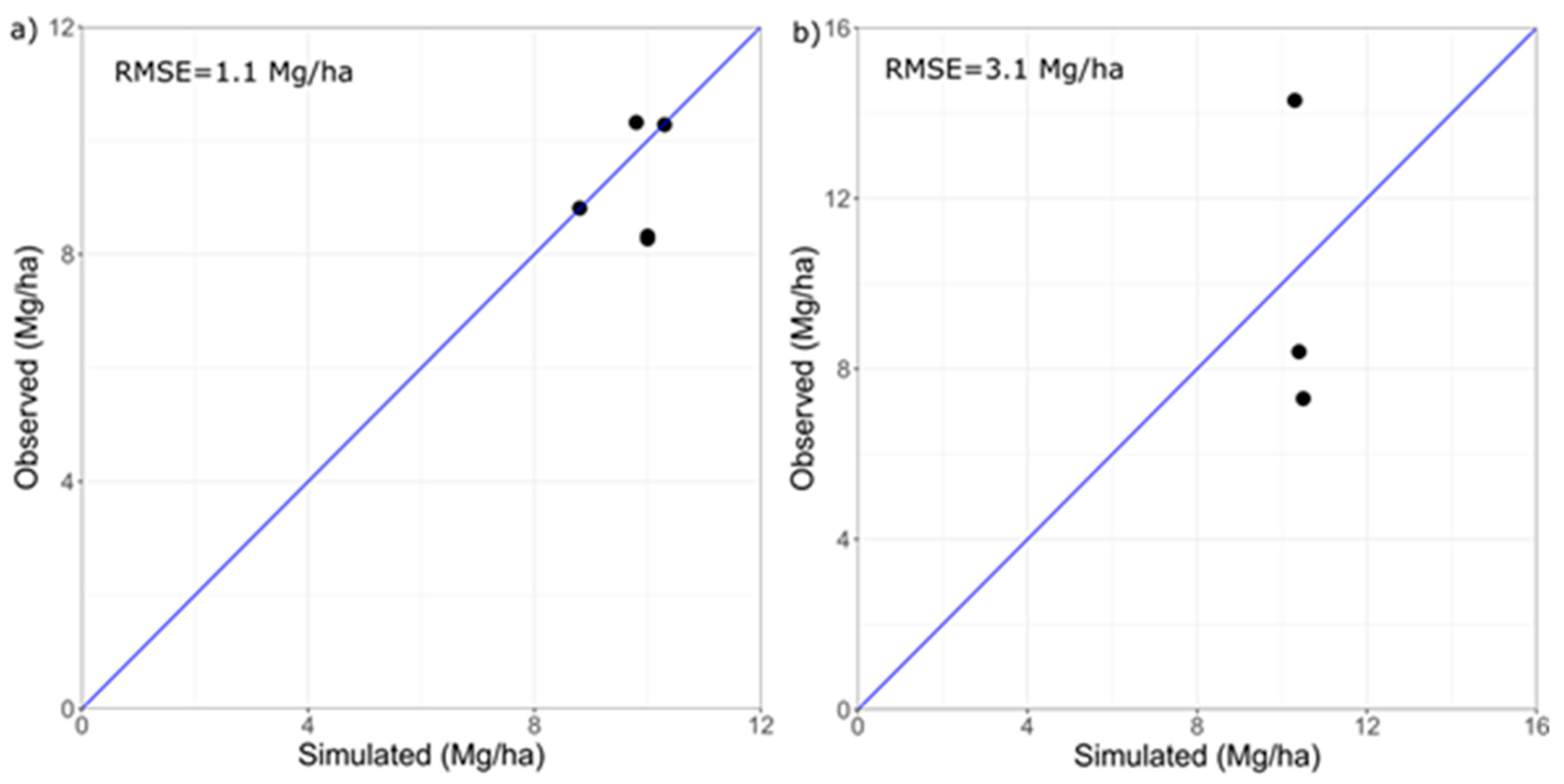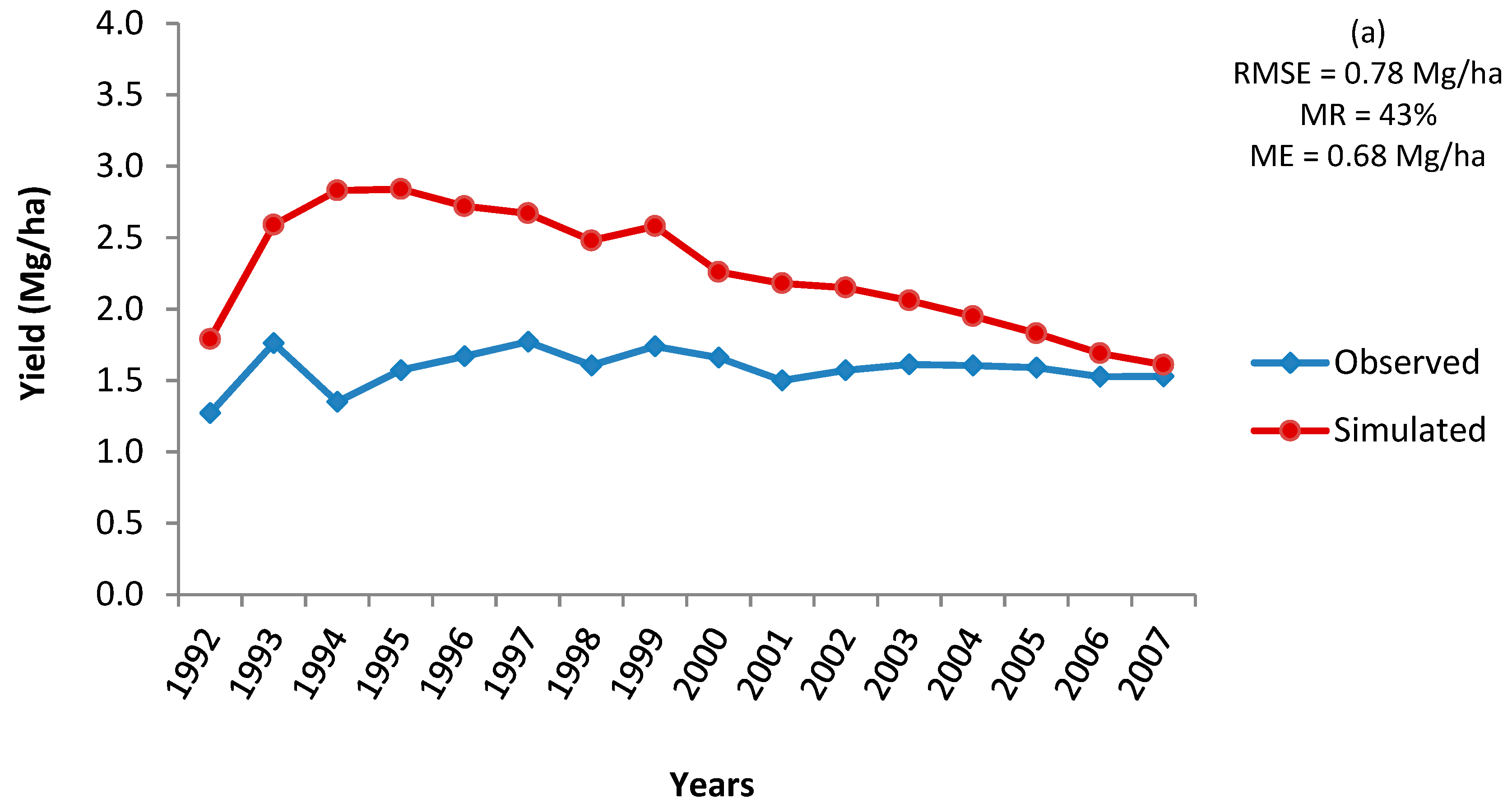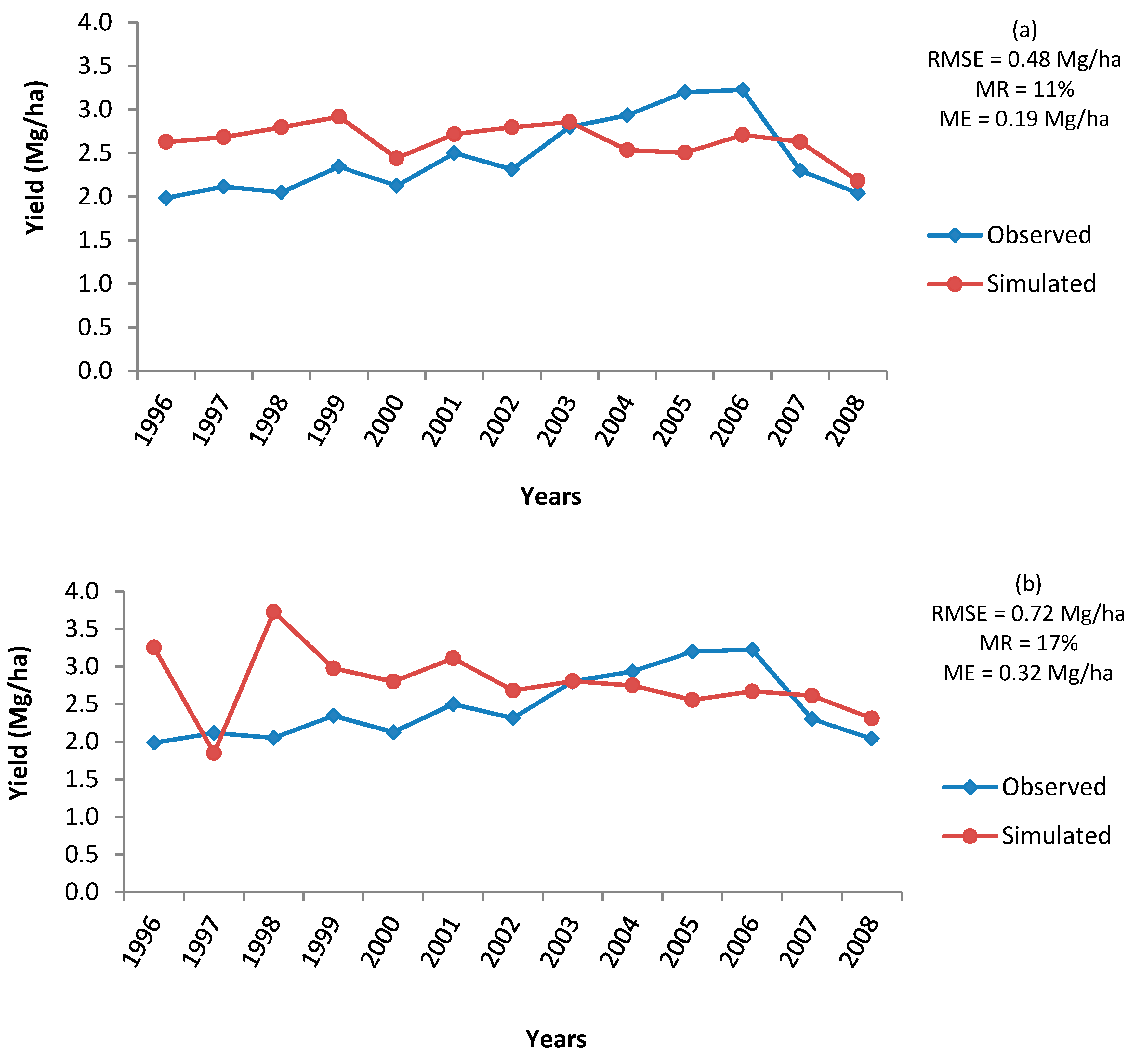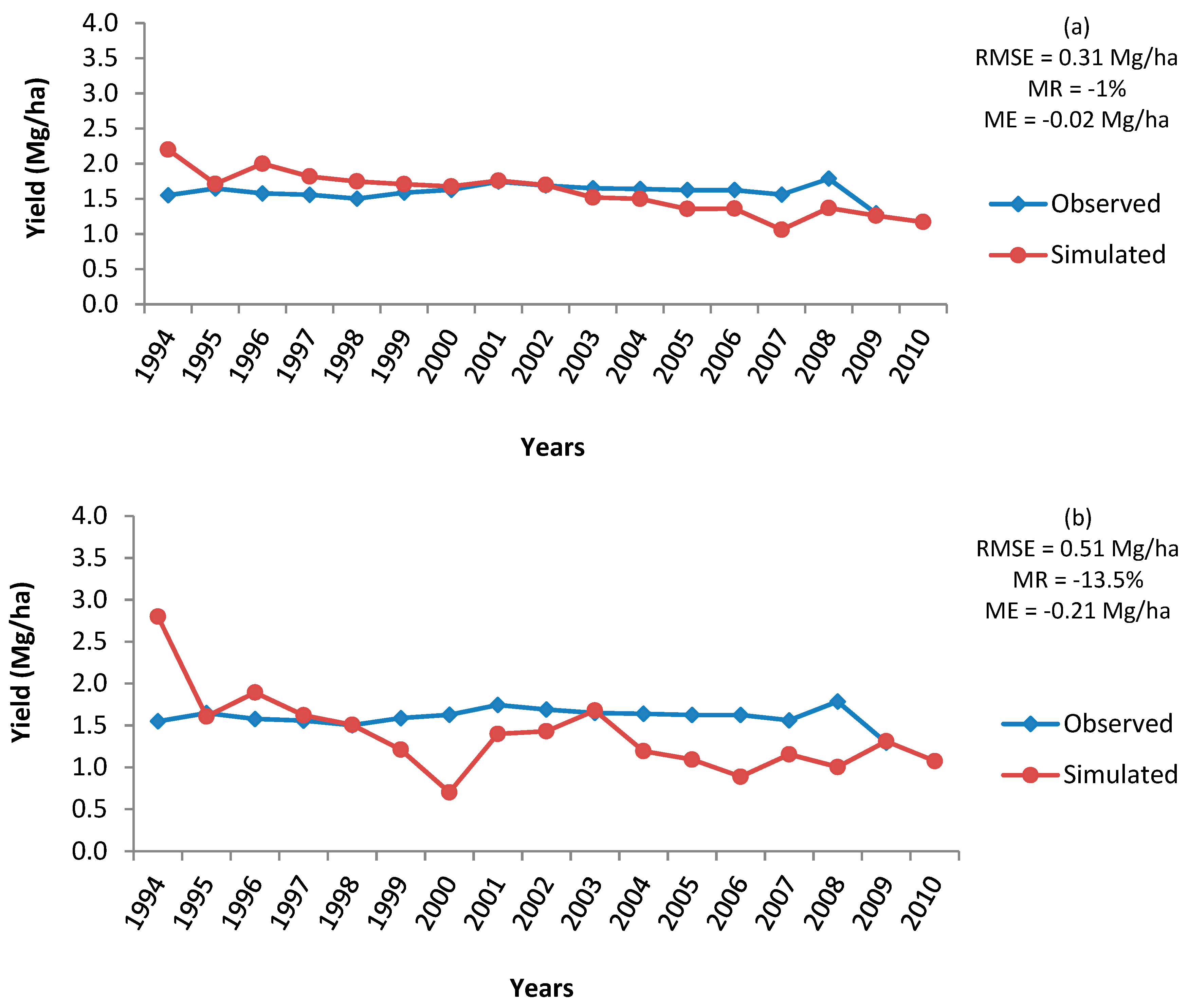3.1. Comparison of Seasonal Weather Variables under Approach 1 and 2
The Modified Mielke index (λ), which was estimated for the crop growth period in the regions of Ghana, Ethiopia and Nigeria, quantified the agreement of the weather variables in datasets obtained under Approach 1 and 2. The highest agreement was estimated in the cumulated radiation values given very high λ values of 0.99 in Ghana, whereas, the least agreement was in cumulated precipitation values (λ = 0.15) (
Table 5). In Ethiopia, the highest agreement was estimated in the cumulated precipitation values (λ = 0.98), whereas, the wind speed was not in agreement in the dataset under Approach 1 and 2 (λ = 0.04) (
Table 5). In Nigeria, the highest disagreement was estimated in precipitation (λ = 0.29) followed by wind speed, global radiation, maximum temperature and minimum temperature, with λ values of 0.46, 0.47, 0.54 and 0.57 respectively (
Table 5). Since the Mielke index estimates not only measure the degree of dependence between the data series from different data sources, but also estimates how similar in the magnitude the series values are. This suggests that, in Ethiopia, as the precipitation and values have highest positive agreement between Approach 1 and 2, both sources of data could be used interchangeably for the assessment of production system under rain-fed conditions. Similarly, In Ghana, the radiation values can be used interchangeably, whereas, in the case of Nigeria, none of the climate variables in both approaches are similar enough in magnitude that they can be used interchangeably under data-scarce conditions.
3.2. Comparison of Simulated Yields based on Approach Land 2
Crop yield is a result of the integration of many biophysical processes. Among others, the yield is driven by five meteorological variables acting in conjunction with each other. Separate simulations of maize phenology and final yield were carried out using the two sources of weather data (namely Approach 1 and 2). The effect of using different weather data sources for simulating grain yield is shown in
Figure 2,
Figure 3 and
Figure 4, whereas the effect on length of vegetative and reproductive phase is shown in
Table 5 for Ghana, Ethiopia and Nigeria. In Ghana, the RMSE of 0.78 Mg/ha was estimated between observed and simulated maize grain yield under Approach 1, whereas it was 0.70 Mg/ha under Approach 2 (
Figure 4). However, in Ethiopia, an RMSE of 0.48 Mg/ha and 0.72 Mg/ha was estimated under Approach 1 and 2 respectively (
Figure 5), while, in Nigeria, the estimated RMSE under Approach 1 and 2 was 0.31 Mg/ha and 0.51 Mg/ha, respectively (
Figure 6). [
44] also reported the lower RMSE 0.70 Mg/ha for soybean yield simulations using the weather data from a single source (in this case, data were obtained from the interpolation of several ground-based station data), compared to the RMSE of 0.86 Mg/ha using the weather dataset compiled from different sources of data (in this case, data were obtained from a reanalysis of satellite and observed weather data).
The correct estimation of crop phenological events is very important for reliable estimates for crop yield by crop models, since they also affect photosynthesis rate and crop sensitivity to water deficit [
45]. There was a close agreement in the duration of simulated vegetative and reproductive phases between the two weather data sources in Ghana and Nigeria, as indicated by the associated low absolute errors (
Table 6). However, in the case of Ethiopia, simulated vegetative and reproductive phases using Approach 2 weather dataset were longer by 8 and 11 days, respectively, with respect to the simulations using the Approach 1 dataset. This could be attributed to the lower mean temperature during the crop growth season under the Approach 2 dataset (
Table 7). These results are in accordance with those observed in the U.S Corn Belt for different gridded weather data (error from 3 to 7 days) [
46]. As the duration of vegetative and reproductive periods is defined by air temperature and photoperiod [
47], the differences in the datasets for these variables were not big enough to cause statistically significant differences in crop phenology estimation.
The impacts of climate variables on crop growth and final yields are interactive; therefore, we used two major factors of crop growth under rain-fed conditions, i.e., radiation and precipitation, and compared the accumulation of solar radiation and precipitation during the crop growth period in the simulations. In Ghana, the accumulated radiation during the crop growth period was 1.9% higher in Approach 2 compared to the Approach 1 dataset, whereas accumulated precipitation was 24.5% higher in Approach 1 compared to that in the Approach 2 dataset (
Table 7). In Ethiopia, the accumulated radiation and precipitation in the crop growth period was higher in the Approach 2 dataset by 12.3% and 9.9%, respectively, compared to the Approach 1 dataset. The same pattern was also estimated in Nigeria, but at a lower magnitude, whereas the accumulated radiation and precipitation in the crop growth period was higher in the Approach 2 dataset by 6.2% and 8.4%, respectively, compared to the Approach 1 dataset (
Table 7).
The inter-annual variability of simulated crop yields can be more important than the mean. Therefore, besides average grain yield over the simulation period, standard deviations of grain yields were estimated from the inter-annual simulations using both weather datasets. The standard deviation in the observed maize yield in Ethiopia was 0.4 Mg/ha, whereas the standard deviations in the simulated yield with Approach 1 and Approach 2 datasets were 0.19 Mg/ha and 0.45 Mg/ha, respectively. The associated variability in the simulated maize yield was, therefore, 58.2% less under Approach 1 compared to those in the Approach 2 dataset, whereas, in Ghana, the standard deviation in the observed maize yield was 0.13 Mg/ha. The standard deviation in the simulated maize yields using the Approach 1 and Approach 2 datasets were 0.42 Mg/ha and 0.45 Mg/ha, respectively, resulting in approximately 8.2% higher variability in the simulated maize yields under the Approach 2 dataset compared to the Approach 1. The same pattern was estimated in Nigeria also, where the standard deviation in the observed maize yield was 0.11 Mg/ha, whereas, the standard deviations in the simulated yield with Approach 1 and Approach 2 datasets were 0.26 Mg/ha and 0.48 Mg/ha, respectively. The associated variability in the simulated maize yield was, therefore, less by 45.6% under Approach 1 compared to those in the Approach 2 dataset. Consequently, it can be inferred that the source of variability in simulated crop yields using Approach 1 and Approach 2 datasets relies on the accuracy of the cumulative precipitation data during the rain-fed growing season of the crop (
Table 7), corroborating the findings of [
12] which suggests that, in rain-fed cropping systems, accurate cumulative precipitation and correct temporal distribution are necessary. Recently, [
48] reported the wheat grain and protein yields are expected to be lower and more variable in most-low-rainfall regions using consistent reanalysis weather dataset highlighting the importance of quality of climate dataset for climate impact assessment studies. [
49] pointed out that the inconsistencies described in the reliability of precipitation data limit the capability of the products for climate monitoring, attribution, and model validation.
The findings of [
50] also highlight the importance of weather dataset consistency. Variability in the wheat and rice yields predictions were in the range of −3 to +4% and −6 to +8%, respectively, using alternative combinations of different input precipitation and temperature datasets.















